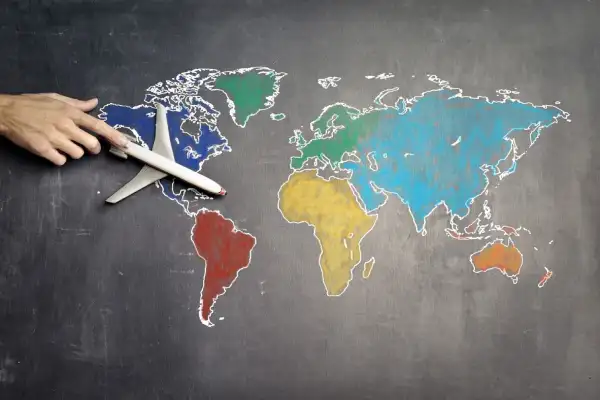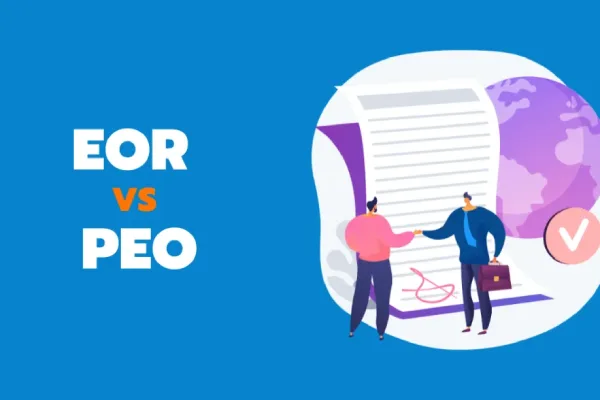Today, 74% of global companies prioritize global mobility to support their international growth (PwC, 2024). Global mobility refers to the strategic practice of relocating employees internationally to achieve business goals. But managing employees across borders is easier said than done.
It involves juggling:
✅ Complex legal requirements
✅ Financial intricacies
✅ Operational hurdles
In this guide, you’ll get practical, easy-to-understand insights into global mobility—including how it works, common challenges, and solutions that can streamline the process. You’ll also discover exactly how an Employer of Record (EOR) can simplify your global employment strategy.
This article covers:
- What is Global Mobility?
- What Does Global Mobility Manage?
- Types of Global Mobility Assignments
- Who is a Global Mobility Consultant and What Do They Do?
- Global Mobility vs. Global Migration: Key Differences
- Common Challenges in Global Mobility
- Employer of Record (EOR) and Its Role in Global Mobility
- Future Trends Shaping Global Mobility
- Frequently Asked Questions (FAQs)
- Conclusion: Simplify Your Global Mobility Today!
What is Global Mobility ?
Global mobility is when companies strategically relocate employees across borders to fulfill business objectives. Historically, global mobility was mostly about sending employees abroad temporarily. But today, it has grown into an essential HR function. It focuses on:
- Strategic talent deployment
- Reducing compliance risks
- Maximizing the value and impact of international assignments
What Does Global Mobility Manage?
Global mobility teams typically manage:
- Immigration & Visas: Securing work permits and legal immigration status.
- Taxation & Payroll Compliance: Managing international tax issues, processing payroll, and meeting social security obligations
- Relocation Logistics: Travel, housing, schooling, and moving services.
- Cultural & Family Integration: Employee support for cultural adaptation, spouse career assistance, and family needs.
- Talent Deployment & Workforce Planning: Assigning employees strategically overseas to support business needs, career development, and future planning.
- Risk & Compliance Management: Identifying and reducing risks related to legal, financial, and operational aspects of international assignments.
- Compensation & Benefits: Designing fair salary packages and allowances to address cost-of-living differences and meet local market standards.
- Technology & Data Management: Using HR technology and data analysis to improve processes, manage assignment information, and support effective decision-making.
Types of Global Mobility Assignments
Companies use different assignment types, depending on their specific needs:
| Mobility Type | Duration | Real-world Example |
| Short-Term Assignment | 3-12 months | An IT consultant sent to Germany temporarily to oversee system implementation. |
| Long-Term Assignment | 1-5 years | A senior manager relocating to Singapore to establish regional operations. |
| Permanent Transfer | Indefinite | Executive permanently moving from Brazil to HQ in the U.S. |
| Commuter Mobility | Frequent, regular travel | Weekly travel between the UK and France for an engineering consultant. |
| Remote International Work | Flexible | Employee based in Spain working remotely for a U.S.-based firm. |
Knowing the types of assignments helps—but equally important is understanding who manages these relocations. That’s the role of Global Mobility Consultants.
Who is a Global Mobility Consultant, and What Do They Do?
A Global Mobility Consultant is a specialist who helps companies manage international employee relocations. They ensure employees relocate smoothly and compliantly, managing everything from paperwork to cultural integration.
Key tasks they handle include:
- Visa and Immigration: Managing work permits and visa applications to ensure legal compliance.
- Tax and Payroll Compliance: Coordinating payroll, withholding taxes properly, and managing international reporting.
- Relocation Logistics: Organizing employee housing, transportation, schooling, and other essentials.
- Cultural Integration: Offering cultural training and support for employees and families to help them adjust easily to new countries.
Illustrative Example (Fictional Scenario):
Consider XYZ Technologies, a U.K.-based tech firm planning to establish a new research hub in Tokyo, Japan. XYZ needs to relocate five senior engineers and their families from London to Tokyo. The relocation process is complex, involving strict immigration rules, unique payroll and taxation regulations, and cultural adaptation issues.
The Global Mobility Consultant supporting XYZ Technologies would:
- Secure Visas & Work Permits:
Prepare necessary documentation and apply for appropriate Japanese work visas, coordinating closely with local immigration authorities to ensure timely approvals. - Manage Payroll and Tax Compliance:
Arrange payroll according to Japanese employment law. Ensure taxes are correctly withheld in Japan, preventing issues such as double taxation between the U.K. and Japan. The consultant would also guide XYZ on local labor laws, such as mandatory health insurance contributions and pension requirements. - Relocation Logistics and Family Support:
Secure housing in Tokyo that suits the employees’ needs. Assist in enrolling children in international schools and arrange orientation programs to help families adjust culturally and practically to Japanese life. - Cultural Training:
Provide customized cultural training sessions to prepare engineers for work-life differences, covering business etiquette, social norms, basic language skills, and local practices.
By partnering with a global mobility consultant, XYZ Technologies simplifies this complex international move. Employees transition smoothly, compliance risks are minimized, and the company launches its Tokyo hub successfully without establishing a local HR infrastructure first.
Global Mobility vs. Global Migration: Key Differences
| Parameter | Global Mobility | Global Migration |
| Initiated by | Company | Individual |
| Purpose | Strategic business objectives | Personal motives (employment, safety, lifestyle) |
| Planning | Planned, structured, business-specific | Often self-planned, flexible, personal |
| Duration | Usually temporary, assignment-based | Often long-term or permanent |
| Compliance Responsibility | Managed by the company (visas, tax, payroll) | Individual’s responsibility |
| Support Provided | Comprehensive company support (relocation, housing, cultural training) | Limited or no external support |
| Example Scenario | A U.S.-based company moves a senior manager to Dubai to open a new regional office. The company handles all visas, taxes, housing, and cultural integration. | An individual from India independently moves to Canada for better career opportunities, arranging visas, employment, and settlement personally. |
Common Challenges in Global Mobility
1. Compliance Risks
Managing immigration and labor regulations internationally is complex. Mistakes may lead to penalties, legal issues, or failed assignments.
2. Taxation Complexity
Handling cross-border payroll and taxation requires deep expertise to avoid double taxation or compliance issues.
3. Employee Retention
Relocations can cause employee dissatisfaction if support systems aren’t strong, leading to early assignment terminations.
Dealing with these global mobility challenges might feel overwhelming. Thankfully, solutions like an Employer of Record (EOR) can simplify these issues significantly.
Employer of Record (EOR) and Its Role in Global Mobility
An Employer of Record (EOR) is an organization legally responsible for employing staff abroad on your behalf—managing payroll, compliance, and local employment obligations. It simplifies international workforce management without requiring companies to establish local subsidiaries.
How Does an EOR Solve Global Mobility Issues?
- Ensures Compliance: Fully handles local employment laws, taxes, and payroll management.
- Rapid Deployment: Quickly onboard employees without lengthy setup processes.
- Cost Reduction: Eliminates the need for expensive overseas infrastructure and compliance management.
Real-life Example:
A U.S. tech startup expanding into Brazil needed immediate local staffing. Using an EOR enabled quick hiring of Brazilian developers without setting up a legal entity. The EOR managed contracts, payroll, taxes, and compliance, cutting market entry time and reducing administrative costs by approximately 65%.
Future Trends Shaping Global Mobility
- AI-Driven Compliance: Automated tools for visa and tax compliance are becoming more common. They simplify processes and reduce errors.
- Hybrid & Remote Work Models: Companies are increasingly adopting flexible global assignments. These assignments blend remote work and physical presence.
- Digital Nomad Visas: More countries are introducing special visas for remote international talent. This trend is reshaping traditional global mobility practices.
Frequently Asked Questions (FAQs)
What steps can companies take to ensure compliance in global mobility?
Companies ensure compliance by:
- Hiring compliance and immigration experts.
- Creating clear internal mobility policies.
- Using digital tools for tracking visas, taxes, and payroll.
- Partnering with Employer of Record (EOR) services or mobility consultants.
- Regularly auditing their global mobility processes.
Which industries benefit the most from global mobility strategies, and why?
Industries benefiting significantly include:
- Tech: To access specialized global talent quickly.
- Consulting: For international project deployments and client needs.
- Finance: To move regulatory experts to global financial hubs.
- Manufacturing & Engineering: To transfer skilled workers internationally for operations.
- Healthcare & Pharmaceuticals: To establish research centers and deploy medical specialists globally.
How exactly does an Employer of Record (EOR) reduce risks in international hiring?
An EOR reduces international hiring risks by:
- Handling local payroll, taxes, and mandatory employment contributions.
- Ensuring compliance with local employment laws and regulations.
- Removing the need for companies to establish their own entities overseas.
- Protecting companies from costly legal and financial penalties related to non-compliance.
- What should companies consider before choosing an EOR provider?
Companies should check an EOR’s local compliance expertise, responsiveness, and cost-transparency. They should also consider the provider’s country-specific experience and client-references.
Simplify Your Global Mobility Today!!!
Managing global mobility involves dealing with legal rules, payroll headaches, and complex relocations. If your company finds these tasks difficult, working with a Global Mobility Consultant or an Employer of Record (EOR) can help.
These experts manage visas, payroll, taxes, compliance, and relocation logistics. This allows your company to expand globally without worrying about administrative burdens or compliance risks.
Isn’t it time to let the experts handle global mobility so you can focus on your company’s growth?
Your next move could make all the difference.







